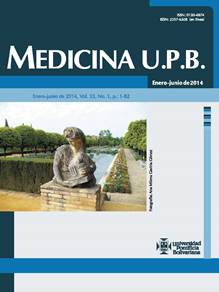Infecciones osteoarticulares no vertebrales por Candida spp. en un hospital de alta complejidad en Medellín, Colombia
Contenido principal del artículo
Resumen
Objetivo: describir las características clínicas y demográficas de pacientes con osteomielitis por Candida spp. en el Hospital Pablo Tobón Uribe de Medellín.
Metodología: observacional descriptiva.
Resultados: se encontraron 30 pacientes con osteomielitis por Candida spp. El 70% está conformado por hombres, con una media de edad de 49.9 años. El 46% tenía como antecedente algún tipo de inmunosupresión. El 60% tenía osteomielitis por Candida spp. como único aislamiento y 40%, osteomielitis bacteriana concomitante. Un paciente tuvo candidemia. El 46% tenía previamente una intervención quirúrgica y el 26% algún tipo de material de osteosíntesis. 26 pacientes (86%) recibieron antibióticos previamente, y son los carbapenémicos, piperacilina, tazobactam y vancomicina los más utilizados. El hueso largo fue el segmento óseo más afectado: 33%. Candida no albicans estuvo en el 63% y Candida spp. en un 3.3%. De Candida no albicans la más frecuente fue Candida. parapsilosis en 57%. El 97% de los aislamientos fue sensible a fluconazol y voriconazol. El 46% completó tratamiento. De un 43% no se obtuvo el dato de seguimiento y el 6.6% no completó el tratamiento.
Conclusiones: la osteomielitis por Candida es una entidad que está en aumento y crea la necesidad de realizar estudios analíticos para explorar los factores de riesgo relacionados. Además, se confirma el aumento de los aislamientos de Candida no albicans que se describe en la literatura y se encontró sólo un caso con sensibilidad intermedia a fluconazol.
Referencias
Lew DP, Waldvogel FA. Osteomyelitis. Lancet. 2004; 364(9431):369-379.
Hogan A, Heppert VG, Suda AJ. Osteomyelitis. Arch Orthop Trauma Surg. 2013; 133(9):1183-1196.
Schnettler R, Steinau H-U, Adams S. Septic bone and joint surgery. Stuttgart Germany ; New York: Thieme; 2010. xi, 313 p. p.
Hennequin C, Bouree P, Hiesse C, Dupont B, Charpentier B. Spondylodiskitis due to Candida albicans: report of two patients who were successfully treated with fluconazole and review of the literature. Clin Infect Dis. 1996; 23(1):176-178.
Miller DJ, Mejicano GC. Vertebral osteomyelitis due to Candida species: case report and literature review. Clin Infect Dis. 2001; 33(4):523-530.
Yuste JR, Alfonso M, Bustos C, Quintana J, Rubio M, Villas C, et al. Iliac bone Candida albicans osteomyelitis in a patient with iliac crest bone autograft: a case report and review of the literature. Infection. 2012; 40(4):445-459.
Yener S, Topcu A, Manisali M, Comlekci A, Yesil S. Candida albicans osteomyelitis in a diabetic foot ulcer. J Diabetes Complications. 2009; 23(2):137-138.
Wellinghausen N, Moericke A, Bundschuh S, Friedrich W, Schulz AS, Gatz SA. Multifocal osteomyelitis caused by Candida dubliniensis. J Med Microbiol. 2009; 58(Pt 3):386-390.
Slenker AK, Keith SW, Horn DL. Two hundred and eleven cases of Candida osteomyelitis: 17 case reports and a review of the literature. Diagn Microbiol Infect Dis. 2012; 73(1):89-93.
Kaldau NC, Brorson S, Jensen PE, Schultz C, Arpi M. Bilateral polymicrobial osteomyelitis with Candida tropicalis and Candida krusei: a case report and an updated literature review. Int J Infect Dis. 2012; 16(1):e16-22.
Arias F, Mata-Essayag S, Landaeta ME, Capriles CH, Perez C, Nunez MJ, et al. Candida albicans osteomyelitis: case report and literature review. Int J Infect Dis. 2004; 8(5):307-314.
Kohli R, Hadley S. Fungal arthritis and osteomyelitis. Infect Dis Clin North Am. 2005; 19(4):831-851.
Gamaletsou MN, Kontoyiannis DP, Sipsas NV, Moriyama B, Alexander E, Roilides E, et al. Candida osteomyelitis: analysis of 207 pediatric and adult cases (1970-2011). Clin Infect Dis. 2012; 55(10):1338-1351.
Tortorano AM, Rigoni AL, Biraghi E, Prigitano A, Viviani MA, Group F-ECS. The European Confederation of Medical Mycology (ECMM) survey of candidaemia in Italy: antifungal susceptibility patterns of 261 non-albicans Candida isolates from blood. J Antimicrob Chemother. 2003; 52(4):679-682.
Performance Standards for Antimicrobial Susceptibility Testing; Twenty-Second Informational Supplement: Clinical and Laboratory Standards Institute; 2012.
European Committee on Antimicrobial Susceptibility Testing (EUCAST); Clinical breakpoints - fungi: Antifungal breakpoints. Version 4.1. http://www.eucast.org/fileadmin/src/media/PDFs/EUCAST_files/AFST/ Antifungal_breakpoints_v_4.1.
Bori G, Soriano A, Garcia S, Mallofre C, Riba J, Mensa J. Usefulness of histological analysis for predicting the presence of microorganisms at the time of reimplantation after hip resection arthroplasty for the treatment of infection. J Bone Joint Surg Am. 2007; 89(6):1232-1237.
Zuluaga AF, Galvis W, Saldarriaga JG, Agudelo M, Salazar BE, Vesga O. Etiologic diagnosis of chronic osteomyelitis: a prospective study. Arch Intern Med. 2006; 166(1):95-100.
Fridkin SK. The changing face of fungal infections in health care settings. Clin Infect Dis. 2005; 41(10):1455-1460.
Arendrup MC. Epidemiology of invasive candidiasis. Curr Opin Crit Care. 2010; 16(5):445-452.
Ece G, Samlioglu P, Akkoclu G, Atalay S, Kose S. The evaluation of the distribution of yeast like fungi ‘Candida Species’ at a tertiary care center in western Turkey. Int J Med Sci. 2012; 9(7):617-620.
Pappas PG, Kauffman CA, Andes D, Benjamin DK, Jr., Calandra TF, Edwards JE, Jr., et al. Clinical practice guidelines for the management of candidiasis: 2009 update by the Infectious Diseases Society of America. Clin Infect Dis. 2009; 48(5):503-535.
Anaissie EJ, Darouiche RO, Abi-Said D, Uzun O, Mera J, Gentry LO, et al. Management of invasive candidal infections: results of a prospective, randomized, multicenter study of fluconazole versus amphotericin B and review of the literature. Clin Infect Dis. 1996; 23(5):964-972.
Rex JH, Pappas PG, Karchmer AW, Sobel J, Edwards JE, Hadley S, et al. A randomized and blinded multicenter trial of high-dose fluconazole plus placebo versus fluconazole plus amphotericin B as therapy for candidemia and its consequences in nonneutropenic subjects. Clin Infect Dis. 2003; 36(10):1221-1228.


